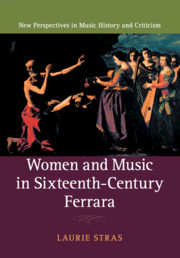Book contents
- Women and Music in Sixteenth-Century Ferrara
- New Perspectives in Music History and Criticism
- Women and Music in Sixteenth-Century Ferrara
- Copyright page
- Dedication
- Contents
- Figures
- Music Examples
- Tables
- Acknowledgments
- Note on Music Prints and Translations
- Abbreviations
- Introduction: Musica secreta
- 1 Ferrarese Convents and the Este in the First Half of the Sixteenth Century
- 2 Courtly Women and Secular Music in Ferrara in the First Half of the Sixteenth Century
- 3 Princesses and Politics: The Este Women and Music in the 1550s
- 4 Actresses and Ariosto: Spectacle and Song in the 1560s
- 5 “Un modo di cantare molto diverso”: Ferrara and the New Singing of the 1570s
- 6 Margherita’s Arrival and the Convents in the First Half of the 1580s
- 7 Musical Practices of the 1580s Concerto
- 8 Ferrara’s Final Chapter: Court and Convents in the 1590s
- 9 Afterlife in Mantua
- Bibliography
- General Index
- Index of Compositions
- References
Bibliography
Published online by Cambridge University Press: 05 September 2018
- Women and Music in Sixteenth-Century Ferrara
- New Perspectives in Music History and Criticism
- Women and Music in Sixteenth-Century Ferrara
- Copyright page
- Dedication
- Contents
- Figures
- Music Examples
- Tables
- Acknowledgments
- Note on Music Prints and Translations
- Abbreviations
- Introduction: Musica secreta
- 1 Ferrarese Convents and the Este in the First Half of the Sixteenth Century
- 2 Courtly Women and Secular Music in Ferrara in the First Half of the Sixteenth Century
- 3 Princesses and Politics: The Este Women and Music in the 1550s
- 4 Actresses and Ariosto: Spectacle and Song in the 1560s
- 5 “Un modo di cantare molto diverso”: Ferrara and the New Singing of the 1570s
- 6 Margherita’s Arrival and the Convents in the First Half of the 1580s
- 7 Musical Practices of the 1580s Concerto
- 8 Ferrara’s Final Chapter: Court and Convents in the 1590s
- 9 Afterlife in Mantua
- Bibliography
- General Index
- Index of Compositions
- References
- Type
- Chapter
- Information
- Women and Music in Sixteenth-Century Ferrara , pp. 341 - 372Publisher: Cambridge University PressPrint publication year: 2018



